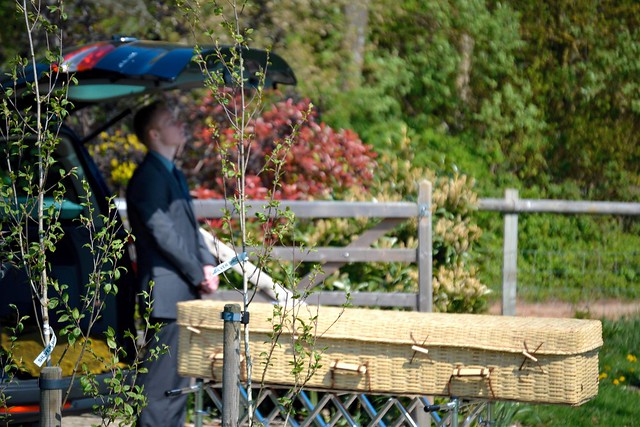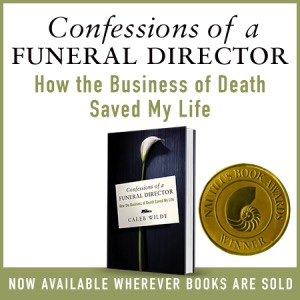Funeral Etiquette
How to Speak the Language of Grief
You walk into a house full of fresh grief. It’s fresh because the death just occurred. Your best friend’s husband went out to the bar last night, drowned his hard day in hard drink and he never made it back home. Fresh. Because both you and your friend have never experienced death this close.
You open the door like you have so many times before, but this time the familiarity of the house is unexpected different, dark and lonely. What once housed parties, life and love now houses something you’ve never known before. Like a river, everything is in the same place it was when you last saw it, but this home has changed.
You see your friend’s children sitting on the sofa, staring into space.
You ask them, “Where’s your mom?”
And as you reach to hug them, they snap back to reality and whisper, “Upstairs.”
Each step brings you closer to what you know is only an apparition of your friend. The nerves build. Fear begins to build. You repress it as you ready yourself to meet your closest friend who has all of a sudden become someone you may no longer know.
“Can I come in?” you ask. No response.
You push open the cracked bedroom door and see the body of your friend collapsed on her bed, with used tissues surrounding her like a moat.
You tip-toe into the room, slowly sit down on the bed, and not sure if she’s awake or asleep, you reach for your friends shoulder and begin rubbing her back. Her blood shot eyes open, look at you and then, they slowly look through you.
You fill the weird silence with an “It’s going to be alright”.
“It’s not”, she whispers. “I’m alone with two kids and no job.” Her voice suddenly raises as anger courses through her body, “Why the f*** would he do this to me?”
The curse word chides you into recognizing that you’ve not only misspoken, but you’ve spoken too soon, so you decide to wait in silence. She starts to cry. You respond to her tears with your own. Even though you want to respond with words, you know this isn’t the time for words. There’s no perfection words here. There’s no perfect anything here. And so you wait.
You stay. Listen. Silence. You take her pain into your soul. Hours pass. She rises out of bed and makes the children dinner.
You’ve spoken, not with words or advice; not by trying to solve the problem; nor by placing a limit on your time. You’ve taken the uncomfortable silence, allow the grace for tears, for brokenness; you’ve allowed yourself to sit in the unrest without trying to fix it.
With your presence. With your love. In your honest acknowledgement of real loss, you’ve spoken the language of grief.
Although the language of grief is usually spoken in love, presence and time, sometimes it’s spoken in words. And when it is, here are five practical “do”s and “don’ts”
The “DON’T”S:
1. At least she lived a long life, many people die young
2. He is in a better place
3. She brought this on herself
4. There is a reason for everything
5. Aren’t you over him yet, he has been dead for awhile now
The “DO”S:
1. I am so sorry for your loss.
2. I wish I had the right words, just know I care.
3. I don’t know how you feel, but I am here to help in anyway I can.
4. You and your loved one will be in my thoughts and prayers.
5. My favorite memory of your loved one is…
Funeral Etiquette for Cell Phones

Cell phones often go off when we least want them to. In church. In school. During sex. And at a funeral. As other funeral directors can attest, the oddest thing about a cell phone ringing during funerals is how many people will actually answer.
“Hello. Yeah. I’m at a funeral service. Can I call you back?”
A funeral director friend once told me that the pastor’s cell phone rang while he was giving the funeral message. He answered it. Confirmed the time for his afternoon golf outing. Hung up and continued on with the service. The family – according to the funeral director – was “pissed.”
If you’re attending a funeral, the best piece of advice I can give you is this: Turn your phone off.
Simple.
But, they aren’t JUST phones. And it isn’t that simple. Funerals also double as family reunions. So, you pull you phone out. Show off your recent photos of your children and your relatives “oh” and “ah” about how much your children look like a young version of your great uncle Ned.
If you keep your phone on, turn it to — preferably — silent and — at least — buzzer.
Is it appropriate to text?
During a viewing and/or visitation, yes. During a funeral, probably not.
As with talking on your cell phone, if you’re going to text it would be polite to step outside or to a discreet area of the funeral home. Sexting, though, is off limits at any time during a funeral.

Can I take a photo of Aunt June laying in her casket?
That’s up to Aunt June’s next of kin. And when you ask, ask before the viewing starts. People aren’t always able to think straight during a viewing, so the polite thing to do is ask while they’re thinking straight … which is before and not during.
Don’t just take a photo like this guy:
I’m bringing the kids to the funeral. Can they play “Angry Birds”?
It’s common sense, but turn the sound off. Everyone else doesn’t need to hear screaming birds and snorting pigs. And, it’s probably NOT appropriate for them to play during the funeral.
“We’re gathered here today to remember the tragic loss of ______” At which time your kid yells “yes” as he overcomes a level that’s taken him a combined 1,000 birds to clear. Not cool.
Also, video. If your children want to watch video on your cell. Either find a separate place that’s out of the way for them to watch. Or, get them to wear headphones.
What do I do when somebody else is breaking funeral cell phone etiquette?
The biggest culprits for committing funeral cell crimes are old men and women who aren’t cell phone savvy. Their phone rings in the middle of the service and they frantically pull it out of their pocket or purse and start hitting buttons. After finding the “silence” button, they breath a sigh of releif ONLY to have their phone start ringing again a minute later.
At this point they start muttering. And it’s at this point someone should step in because if you don’t their next action will be to turn it off, which will only create another loud “turning off” noise and more muttering.
The difficulty isn’t with the cell phone newbies, it’s with the cell phone addicted. The young people. And when young people commit cell phone faux pas, and you can tell that it’s annoying people around them, you have to confront them.
“Excuse me. Can you please turn your cell phone off?” Then wait until they turn it off. That’s what I do.
And if they don’t turn it off, pray for cell phone karma (example of cell phone karma in the video below)
Grief Online: The Dos and Don’ts of Internet Etiquette
Today’s guest post is written by Dr. Candi K. Cann
Everyone seems to be online these days, and even if you are not on much, odds are that you have a Facebook, Twitter, Pinterest, Tumblr or Instagram account. With so much of our socializing done virtually, it is no surprise that we are grieving and mourning the deaths of our loved ones online too.
Here are a few Dos and Don’ts for grieving online.
• Don’t announce the death of someone online unless you are sure that the family, friends and anyone that should know about the death, knows already.
The most recent example of this was Wall Street Journal’s breaking news tweet on Philip Seymour Hoffman’s death. Both the death and the details of how he died were tweeted before his family was aware that he had died.
• Once everyone knows about the death, it is okay to post details about the funeral, wake, celebration of life ceremony online so that everyone knows, but please don’t create an Evite for it.
Evites are great for invitations — they are convenient and quick, but they shouldn’t be used in this case for three reasons:
1) They depend on the regular checking of email, and since funerals and memorials are generally held somewhat quickly, those invited may not get the email in time.
2) Evites sometimes land in the invitee’s junk folder, which means they won’t receive them, and funerals and memorials are meant to be open to anyone the deceased knew.
3) Evites are only for those that receive an invitation.
• If someone is posting a picture of themselves with the deceased, they are doing so to let you know they are grieving, so don’t write snarky comments on that picture.
Don’t do it. Just don’t. It isn’t the right time or place.
 • If a family decides to leave a Facebook page active, a Twitter feed open, or an Instagram account on so that you can write comments, post messages, etc., please think about your audience.
• If a family decides to leave a Facebook page active, a Twitter feed open, or an Instagram account on so that you can write comments, post messages, etc., please think about your audience.
Yes, we know you were Tom’s last serious girlfriend before his marriage, and probably the reason he finally got his act together to be able to commit to his wife and have children, but that doesn’t mean you should post old love letters or pictures to his webpage. His wife and all the rest of his family just won’t find it appropriate, and it might make their grief worse.
And yes, your position as ex-girlfriend means that you have a right to grieve, and that there is really no place for you to do so, but you will need to stick to your group of girlfriends, or maybe on your own private social media. While the Internet is awesome for giving everyone a voice, sometimes we need to think about our audience.
• Don’t write negative things about the dead.
Yes, your neighbor was a jerk, but if you didn’t say it to his face before he died, then it’s too late now. If you did, then he already knows how you feel, and there’s just no point in making his family and friends feel worse.
• Along those lines, don’t say anything negative about the living posting about the dead.
Yes, we are all getting tired of Katie’s sappy (and badly written, I might add) poems that she keeps writing and posting to her deceased best friend’s page, but please don’t say anything. Remember the old adage — if you can’t say anything nice, then don’t say anything at all? Well, remember it. Or at least, if you must say something that’s not nice, then say it to a close friend who has never met Katie. That way you can be sure Katie won’t find out.
And last, but not least, those funeral selfies.
• If you insist on taking a funeral selfie, try to keep the dead out of the pictures.
There’s a reason some people don’t go to wakes or funerals — they simply don’t know what to do with that open casket. Or maybe they want their last memory of Grandma to be a living one. If you must take a funeral selfie, please make sure there are no glimpses of Grandma in her casket. It’s bad enough we have to see pictures of your cute cat five times a day, we really don’t want to see your dead grandmother before we’ve even had our morning coffee.
*****
ABOUT THE AUTHOR: Candi K. Cann received both her A.M. and Ph.D. in Comparative Religion from Harvard University, and her research focuses on death and dying, and the impact of remembering (and forgetting) in shaping how lives are recalled, remembered and celebrated. An avid reader, traveler, and lover of poetry, her passions are spending time with her family and friends and living well.
You can follow Candi on Twitter and pre-order her upcoming book, Virtual Afterlives: Grieving the Dead in the Twenty-First Century.
10 Thoughts in Defense of Funeral Selfies
As is often the case, we tend to get house calls in the middle of snow storms. And this past week was no different. I plowed out the funeral home’s parking lot, pulled out the pick-up van and we were on our way. We arrived to a packed house where family and friends encircled the deceased in a garrison of grief.
“Direct cremation”, the family said. “That’s what she wanted.” As is our modus operandi we assured them, “Take as long as you need to say your good-byes.” And with that permission, six members of the family proceeded to pull out their cell phones, leaned down and took a photo with the deceased.
Funeral photography, funeral selfies and “corpsies” via mobile devices are becoming more and more normal at death beds AND funerals, despite the fact that they’re seen by many as pure sacrilege. Huffington Post stated that such images are “evidence the apocalypse can’t come soon enough.” And with the boneheaded cadaver selfie and this photo below (read more HERE) in the news lately, it’s no wonder the Huffington Post feels the way they do. And let me be clear, the cadaver selfie and this boneheaded photo below AREN’T cool and they AREN’T the funeral selfies that I’m defending.
I myself once felt uncomfortable with the idea of deathbed / funeral selfies, but as I’ve seen more and more people take these photos, I’ve slowly become more open. Here’s why:
One. There’s a long history of funeral photography. Heck, I think there’s a one million year old photo of a dead Homo erectus floating around the internet.
Two. Unlike the cadaver selfie or the photo above, funeral photography is usually motivated by some kind of love.
Intent is part of the issue when talking about funerals and photography, etc. Why do it? What’s the motivation? And although the motivation isn’t always clear, it IS clear most take these photos as a token of remembrance. A token of love.
Three. If you happen upon a dead Sasquatch, there’s no decorum … snuggle up to dead Bigfoot and TAKE THAT SELFIE!
Four: Selfies don’t equal narcissism.
The very term “narcissism” comes from the Greek myth of Narcissus. Narcissus was drawn to a pool of water, where he saw his reflection and fell in love with it. He was so fixated upon his beauty that he never left his reflection until his death.
At first glance, selfies would seem like the epitome of narcissism, and indeed many are self-serving. But many (most) are about belonging.
Five. Emerging culture cares more about belonging than decorum.
We’ve moved from the neatly defined groups/tribes of pluralism to the blending of fragmentation. We are like quilts. We’re like a mosaic.
With fragmentation, the social rules that come with the strictly defined boundaries of pluralism become less and less important. With fragmentation, belonging and identity become of prime importance. Belonging and identity is decorum.
Six. Deathbed / funeral selfies are often about belonging.
Social media is how many of us relate to the world. We communicate through texts, facebook messages and photos. The selfie is a way of saying “this is where I am at … this is what I’m doing … this is who I am.” And the funeral selfie is how we say, “This part of my community has died and I just wanted to let you know.” In the minds of many, taking a selfie with the deceased is right because it’s about expressing a connection to the deceased and wanting to share that connection with others. It’s about identity and belonging.
Seven. Permission.
That’s the thing. If you want to take any form of funeral photography, ask first. While you may be a part of emerging culture, it’s likely your parents, grandparents, aunts and uncles are NOT. They have a sense of decorum that you might lack, so ask their permission before you take your photos. And for god’s sake, don’t jump in the casket so you can get “a really good close up”. And, if the deceased has a Facebook or twitter account, it’s probably not good to tag them in your photo.
Eight. More permission.
Just because you have permission to take the photo doesn’t mean you have permission to share the photo on Facebook. Yeah, we love you and we love your grandmother, but when we’re sitting down to eat some meatloaf for dinner we’re not THAT interested in having your corpsie show up in our Instagram feed.
So, share it in a closed group … or with specific friends.
Nine. More professionalism.
People like a degree of professionalism around death. I think in the future, as deathbed / funeral photograph gains some ground, we’ll find more professional ways to photograph the dead … and maybe we’ll even hire death photographers.
Ten. Since social media is how the younger generation relates with the world, it will likely be how the younger generation relates with death.
So, a funeral selfie isn’t about stupid kids and their narcissistic attempts to express themselves. It’s about how they/we relate with a world that’s being defined more and more by globalization and fragmentation … it’s about belonging.
Good ahead. Get permission. And take those photos.
11 Worst and Best Things to Say at a Funeral
I’m often asked, “What are the best and worst things to say at a funeral?” And it’s a great question to ask because the right words can help speed up healing, while the wrong words can delay the grief process by days, maybe even months.
I stumbled across this list from Grief.com and thought they were very helpful. Of course, there may be one or two pieces of advice that should be taken lightly.
The Worst Things to Say to Someone in Grief
- At least she lived a long life, many people die young
- He is in a better place
- She brought this on herself
- Edward Cullen does not exist and even if he did, he wouldn’t bite your loved one
- There is a reason for everything
- Aren’t you over him yet, he has been dead for awhile now
- You can have another child still
- She was such a good person God wanted her to be with him
- I know how you feel
- She did what she came here to do and it was her time to go
- Be strong
The Best Things to Say to Someone in Grief
- I am so sorry for your loss.
- I wish I had the right words, just know I care.
- I don’t know how you feel, but I am here to help in anyway I can.
- You and your loved one will be in my thoughts and prayers.
- I have a ton of bacon in my car with your name on it.
- My favorite memory of your loved one is…
- I am always just a phone call away
- Give a hug instead of saying something
- We all need help at times like this, I am here for you
- I am usually up early or late, if you need anything
- Saying nothing, just be with the person
Taken (mostly) verbatim from the incredibly helpful Grief.com
If you’d like to share your experiences with what should or shouldn’t be said, please feel free to share. Or, if you agree or disagree with any of the above suggestions, let me know!



